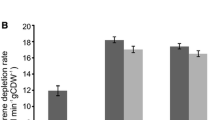Abstract
Duloxetine intermediate (S)-(-)-3-N-methylamino-1-(2-thienyl)-1-propanol was synthesized using ACA liquid-core immobilized Saccharomyces cerevisiae CGMCC No. 2230. The optimum culture time for ACA liquid-core immobilized cells was found to be 28 h. The optimum ACA liquid-core capsule formation conditions were found to be 90 % chitosan deacetylation, 30,000–50,000 chitosan molecular weight, 5.0 g/L chitosan, and pH 6.0 citrate buffer solution. The highest activity was found when reduction conditions were pH 6.0, 30 °C and 180 rpm. The ACA-immobilized cells can be reused nine times and only 40 % of the activity is retained after nine cycles. Product inhibition of reduction was observed in batch reduction. Continuous reduction in the membrane reactor was found to remove the product inhibition on reduction and improve production capacity. Conversion reached 100 % and enantiometric excess of (S)-(-)-3-N-methylamino-1-(2-thienyl)-1-propanol exceeded 99.0 % in continuous reduction of 5 g/L 3-N-methylamino-1-(2-thienyl)-1-propanone in the membrane reactor.







Similar content being viewed by others
References
Moore K (2004) Duloxetine: a new approach for treating stress urinary incontinence. Int J Gynaecol Obstet 86(1):53–62
Mallinckrodt CH, Prakash A, Andorn AC, Watkin JG, Wohlreich MM (2006) Duloxetine for the treatment of major depressive disorder: a closer look at efficacy and safety data across the approved dose range. J Psychiat Res 40(4):337–348
Perahia DGS, Wang F, Mallinckrodt CH, Walker DJ, Detke MJ (2006) Duloxetine in the treatment of major depressive disorder: a placebo- and paroxetine-controlled trial. Eur Psychiat 21(6):367–378
Chang X, Yang ZH, Zeng R, Yang G, Yan JB (2010) Production of chiral aromatic alcohol by asymmetric reduction with vegetable catalyst. Chinese J Chem Eng 18(6):1029–1033
Sainz-Diaz CI, Wohlfahrt G, Nogoceke E, Hernández-Laguna A, Smeyers YG, Menge U (1997) Molecular structure and conformational analysis of chiral alcohols. Application to the enantioselectivity study of lipases. J Mol Struct Theochem 390(1):225–237
Kometani T, Yoshii H, Matsuno R (1996) Large-scale production of chiral alcohols with bakers’ yeast. J Mol Catal B Enzym 1(2):45–52
Richter N, Gröger H, Hummel W (2011) Asymmetric reduction of activated alkenes using an enoate reductase from Gluconobacter oxydans. Appl Microbiol Biotechnol 89(1):79–89
Ou ZM, Shi HB, Sun XY, Shen WH (2011) Synthesis of S-licarbazepine by asymmetric reduction of oxcarbazepine with Saccharomyces cerevisiae CGMCC No. 2266. J Mol Catal B Enzym 72(3):294–297
Engelking H, Pfaller R, Wich G, Weuster-Botz D (2006) Reaction engineering studies on β-ketoester reductions with whole cells of recombinant Saccharomyces cerevisiae. Enzym Microb Technol 38(3–4):536–544
Matsuda M, Yamazaki T, Fuhshuku K, Sugai T (2007) First total synthesis of modiolide A, based on the whole-cell yeast-catalyzed asymmetric reduction of a propargyl ketone. Tetrahedron 63(36):8752–8760
Korbekandi H, Mather P, Gardiner J, Stephens G (2008) Reduction of aliphatic nitro groups using an obligately anaerobic whole cell biocatalyst. Enzyme Microb Technol 42(4):308–314
Bräutigam S, Dennewald D, Schürmann M, Lutje-Spelberg J, Pitner WR, Weuster-Botz D (2009) Whole-cell biocatalysis: evaluation of new hydrophobic ionic liquids for efficient asymmetric reduction of prochiral ketones. Enzyme Microb Technol 45(4):310–316
Pfruender H, Jones R, Weuster-Botz D (2006) Water immiscible ionic liquids as solvents for whole cell biocatalysis. J Biotechnol 124(1):182–190
Xiao ZJ, Du PX, Lou WY, Wu H, Zong MH (2012) Using water-miscible ionic liquids to improve the biocatalytic anti-Prelog asymmetric reduction of prochiral ketones with whole cells of Acetobacter sp. CCTCC. Chem Eng Sci 84:695–705
Schroer K, Mackfeld U, Tan IAW, Wandrey C, Heuser F, Bringer-Meyer S, Weckbecker A, Hummel W, Daußmann T, Pfaller R, Liese A, Lütz S (2007) Continuous asymmetric ketone reduction processes with recombinant Escherichia coli. J Biotechnol 132(4):438–444
Piovan L, Kagohara E, Ricci LC, Keppler AF, Capelari M, Andrade LH, Comasseto JV, Porto ALM (2008) Chemoselective screening for the reduction of a chiral functionalised (±)-2-(phenylthio)cyclohexanone by whole cells of Brazilian micro-organisms. Tetrahedron Asymmetry 19(20):2385–2389
Ni Y, Xu JH (2012) Biocatalytic ketone reduction: a green and efficient access to enantiopur alcohols. Biotechnol Adv 30:1279–1288
Wohlgemuth R (2010) Asymmetric biocatalysis with microbial enzymes and cells. Curr Opin Microbiol 13(3):283–292
Kurbanoglu EB, Zilbeyaz K, Kurbanoglu NI (2011) Cryptococcus laurentii as a new biocatalyst for the asymmetric reduction of substituted acetophenones. Tetrahedron Asymmetry 22(3):345–350
Kurbanoglu EB, Zilbeyaz K, Ozdal M, Taskin M, Kurbanoglu NI (2010) Asymmetric reduction of substituted acetophenones using once immobilized Rhodotorula glutinis cells. Bioresource Technol 101(11):3825–3829
Sun ZJ, Li SY, Lv GJ, Zhu J, Yu WT, Wang W, Ma XJ (2008) Metabolic response of different osmo-sensitive Sacchromyces cerevisiae to ACA microcapsule. Enzyme Microb Technol 42(7):576–582
Qi WT, Ma J, Yu WT, Xie YB, Wang W, Ma XJ (2006) Behavior of microbial growth and metabolism in alginate-chitosan-alginate (ACA) microcapsules. Enzyme Microb Technol 38(5):697–704
Acknowledgments
We thank the Natural Science Foundation of Zhejiang Province (Y4110130), the Technology Department of Zhejiang Province (2007C33047) and Natural Science Foundation of China (21106132) for the financial support.
Author information
Authors and Affiliations
Corresponding author
Rights and permissions
About this article
Cite this article
Zhimin, O., Haibing, Z., Lan, T. et al. Asymmetric synthesis of duloxetine intermediate (S)-(-)-3-N-methylamino-1-(2-thienyl)-1-propanol using immobilized Saccharomyces cerevisiae in liquid-core sodium alginate/chitosan/sodium alginate microcapsules. Bioprocess Biosyst Eng 37, 2243–2250 (2014). https://doi.org/10.1007/s00449-014-1202-9
Received:
Accepted:
Published:
Issue Date:
DOI: https://doi.org/10.1007/s00449-014-1202-9




